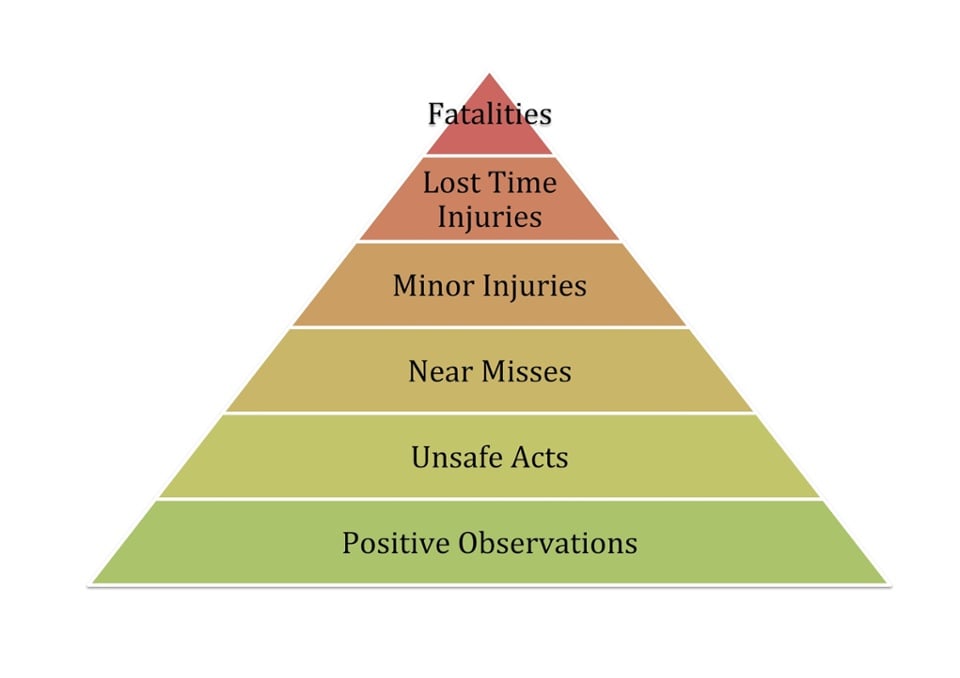This blog post has been originally published in July 2016.
Incident reporting is crucial in every workplace, but prior to creating an incident report, every HSEQ manager should understand different safety categories and emphasise the importance of positive observations. Clear pre-determined categories facilitate continuous reporting. This will help organisations avoid and mitigate potential occupational dangers in their field operations.
Six distinct incident categories
All possible work-related incidents can be divided into six different categories depending on their status. We demonstrate these categories with a triangle, that has the rarest incidents or observations on the top and the most common ones on the bottom.
 The illustration is an adaptation of Heinrich’s Triangle. The first top five categories are from the original framework, but the bottom category Positive Observations is an additional layer defined by us. When thinking about organisations, the ratio between these six categories is important. Positive observations are the ones which should be the most numerous in any company.
The illustration is an adaptation of Heinrich’s Triangle. The first top five categories are from the original framework, but the bottom category Positive Observations is an additional layer defined by us. When thinking about organisations, the ratio between these six categories is important. Positive observations are the ones which should be the most numerous in any company.
The top category is self-explanatory - fatalities are the most severe workplace incidents that can happen. The second category, lost time injuries, refers to injuries that cause the employee a permanent or nonpermanent injury that keeps the employee out of work for some time. These types of injuries may vary from sprained ankles to broken bones or even amputations.
Minor injuries and near misses are exactly what the titles entail. A minor injury is an event where somebody gets hurt, but the person doesn’t need to take time off from work. Near misses refer to events where nobody gets hurt, but it’s close. A good example is imagining a pile of wood panels falling off a shelf when a worker is standing nearby. He or she doesn’t get hit, but there was a high possibility for a more severe incident.
Unsafe acts refer to behaviour and circumstances that don’t necessarily produce direct danger to anyone but are seen as matters to be fixed. A good example of an unsafe act is not wearing a helmet at a construction site.

Positive observations highlight acts of safety
The sixth category, positive observations, refers to all those observations that highlight safe behaviour at the workplace. Examples of positive observations are:
- Everybody is wearing a safety helmet at all times at a constructions site
- Supervisors show sincere interest in employees’ safety and act immediately if a problem arises
- Employees are well-informed about the exit routes at a work site
- There are clear instructions on how to report different observations to supervisors
- Employees are familiar with company safety policies
Many companies fail by concentrating on collecting data from only the top five categories of the triangle. And Positive observations shouldn’t be left out. Collecting positive data is extremely important in order to predict the number and type of future incidents. Negative events usually result in blaming the person accountable whereas the same person also often deserves praise for other jobs well-done. The focus shouldn’t be only on spotting the mistakes, but rather on noticing good safety and security efforts. Moreover, collecting these types of data is also a way of preventing uncertainty and increasing the knowledge of what a good safety and security culture looks like.
Final Thoughts
When thinking about incident reporting, it's extremely important to understand the nature and role of different categories. They help organisations to build their safety culture and develop causalities and leading indicators to predict risks in the working environment.
Once you are familiar with the different categories, it is time to consider the best way to collect all these observations. We are covering the topic here: How to Make an Incident Report.
If you're looking for a platform to collect more data to have better integration of incident reporting, we've got you covered. Falcony is easy-to-use, boosts two-way communication, has customisable workflows, automated analytics, vast integration possibilities and more. Start your 30-day trial or contact us for more information.

We are building the world's first operational involvement platform. Our mission is to make the process of finding, sharing, fixing and learning from issues and observations as easy as thinking about them and as rewarding as being remembered for them.
By doing this, we are making work more meaningful for all parties involved.
More information at falcony.io.







